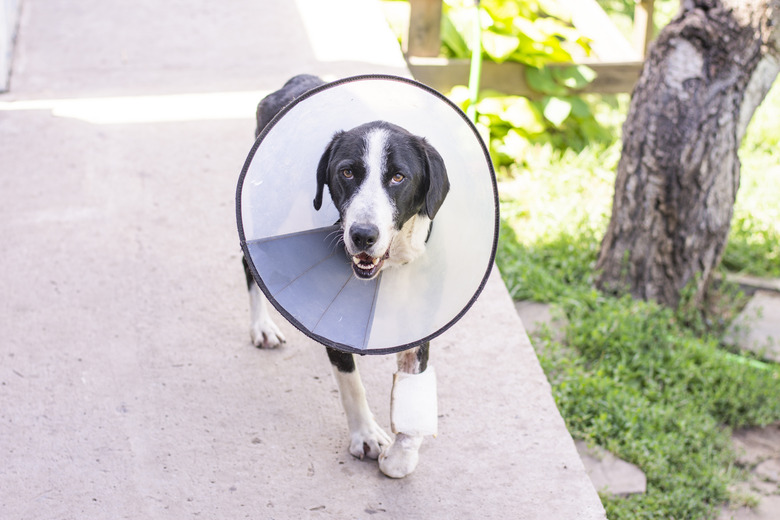How To Determine If A Dog Needs Stitches
There isn't much that will send a pet parent into an emotional tailspin like a fresh injury on their beloved pet. Many dogs, particularly young or naturally playful and rambunctious ones, end up with cuts and scrapes on occasion, and much of the time, it's not cause for too much concern. Sometimes, however, an injury can result in a wound that is deep and may cause your dog pain. If you're unsure whether to take your dog to the veterinarian after you notice a wound, there are a few things to know.
Seeking medical attention for your dog
Seeking medical attention for your dog
If you notice a wound on your dog and you're on the fence about whether you should take them to your veterinarian, it's ideal if you're able to do so. However, not all abrasions and minor injuries require medical attention from a professional, and some will either heal on their own or can be easily addressed at home.
But a bite wound from another animal is more concerning. The mouths of cats, dogs, and wildlife are filled with bacteria, which can contaminate an open wound. Also, some wildlife can carry rabies, and cats and dogs who aren't current on their rabies vaccine are at risk for getting rabies. This is another good reason to seek veterinary care for a bite wound.
Does my dog need stitches?
Does my dog need stitches?
If your dog's injury has any of the following, they may need stitches and other veterinary treatment:
- The wound was created by a dirty object
- It continues to bleed after 15 minutes of pressure
- It's an open wound or laceration where you can see fat, muscle, or bone
- It's a deep cut that is a quarter of an inch or more
- The wound is over a joint
Also, anything that is causing your dog obvious physical pain needs veterinary attention. Burns require a trip to your veterinarian as well.
Dog wound infection symptoms
Dog wound infection symptoms
An infected wound on a dog should always be looked at by a veterinarian, as oral antibiotics and possibly pain medication may be needed to help your dog get well. If your dog has a bite or cut, infection symptoms to look out for include swelling that is tender to the touch, dead skin tissue, the formation of abscesses, redness, or pus.
A foul odor coming from the wound site also indicates that an infection is present. Infected wounds, like abscesses, will not respond to home care with things like Neosporin antibiotic ointment.
Infection symptoms commonly appear at the site of the injury, although some signs may manifest in other ways. If your dog is showing signs of weakness, difficulty breathing, or pale gums or if your dog faints or collapses, you should take them to the veterinarian immediately.
Keep a close eye on the affected area when your dog becomes injured, both immediately and for the next week to ensure that the wound is healing naturally and that no signs of infection are present. If your dog's appetite goes down or if you're unsure of anything, call your veterinarian.
What to do when you can't get your dog to the veterinarian
What to do when you can't get your dog to the veterinarian
If for some reason you can't take your dog to see a medical professional for minor wounds, provide first aid to your pet by keeping the affected area clean to help prevent possible infections. Stop any bleeding with gentle pressure before flushing the wound with normal saline flush. You can find normal saline in the first-aid aisle of stores, and it may be labeled "wound wash."
Then, disinfect the wound with an antiseptic that's been diluted, like iodine, but do not use hydrogen peroxide because it can actually slow down the wound-healing process. If your dog is licking or chewing at the wound, they'll need to wear an Elizabethan collar (or possibly wear a T-shirt) to help reduce the risk of infection. If you need to bandage the wound for some reason, keep in mind that any bandage material needs to be changed daily.
The bottom line
The bottom line
Sometimes, pet owners may be on the fence about whether their dog's cut or wound might need stitches or other veterinary treatment. If you're able to have your dog seen by a veterinarian for wound care, that is ideal, as even small bites can become infected. A professional is also the best one to determine if wound closure is needed. If you aren't able to take your dog to your DVM, watch for signs of infection, such as foul odor, swelling, and discharge. If your pet licks or chews at the wound, you'll need to use an e-collar.


